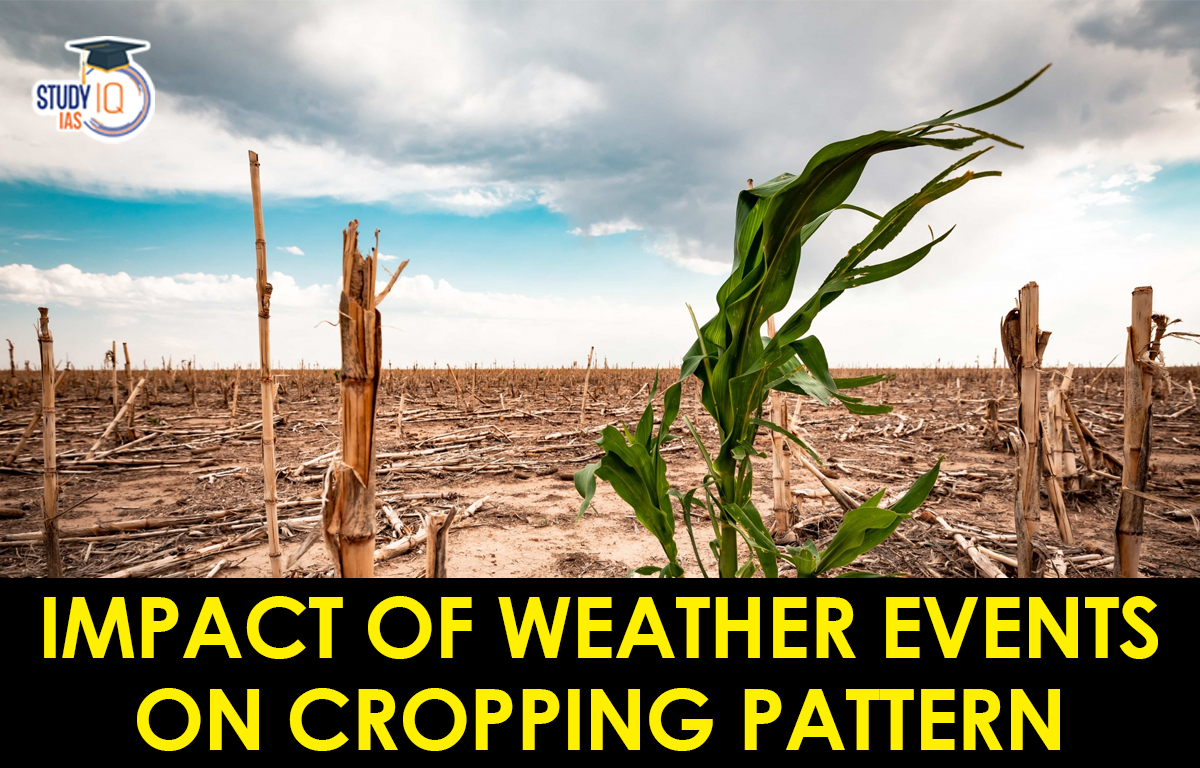Table of Contents
Context: Untimely rains in India’s key grain-producing States have left wheat-growing farmers worried as they anticipate a drop in yield, output and quality.
Background: Agriculture and Climate Change:
- Weather plays a major role in determining the success of agricultural pursuits. Climatic changes driven by increasing Green House Gases (GHGs) possibly affects the yield and productivity of agricultural crops from region to region.
- Agriculture which accounts for 15% of India’s GDP and 43% of employment is the most vulnerable to climate change.
- Climate change poses a challenge to food security challenges with its influence on food production, costs, and security.
- Excessive heat or shortage of water can impede crop growth, reduce yields, and influence irrigation, soil quality, and the ecosystem on which agriculture depends.
How do Weather Events Affect the Cropping Pattern?
- Decrease in yield: In India, an increase in temperature by 1.5° C and decrease in the precipitation of 2 mm, reduces the rice yield by 3 to 15%.
- The predicted higher day temperatures by 3-5 degrees for the prevailing current season in Uttar Pradesh, Madhya Pradesh, Punjab, Haryana and Rajasthan will affect the yield of the wheat crop.
- It is being speculated that the effect of El Niño will lower the summer crops production in India as El Niño affects the monsoon winds into India and creates drought conditions.
- Loss in production: Adverse weather conditions can cause production losses, especially if experienced during critical stages of growth.
- After the rain-deficient sowing period of paddy, the excess rainfall just before harvesting in Uttar Pradesh will decrease the production of paddy by 6% from 2021 in the State.
- Lowers quality of produce: Change in weather conditions affects the quality of crops also.
- For instance, excess rainfall during the flowering season affected the quality of cashew nut in Kerala.
- Increase in pests: Variations in temperature and relative humidity facilitate the emergence of new pests and diseases, leaving many crops susceptible to attacks and outbreaks.
- Reduction in soil nutrients: Extreme rainfall events in India have been wiping out soil nutrient reserves, generating a negative impact on the crops.

Impact of Climate Change in India
- Calamity: According to the Global Climate Risk Index 2021, India is among the top ten countries most affected by climate change.
- Hydro-meteorological calamities, including heavy rainfall and floods, have damaged 33.9 million hectares of India’s cropped area between 2015-16 and 2021-22.
- Effects on agriculture:
-
- Rain-fed rice yields in India are projected to reduce by 20% in 2050 and 47% in 2080 scenarios.
- Irrigated rice yields are projected to reduce by 3.5% in 2050 and 5% in 2080 scenarios.
- Wheat yield shall be reduced by 19.3% in 2050 and 40% in 2080 scenarios.
- The kharif maize yields are projected to reduce by 18% and 23% in 2050 and 2080 scenarios, respectively.
-
- Food security: The damage caused to agriculture by climate change dents India’s food security. Climate change may push many Indians towards hunger by 2030 due to a decline in agricultural production and disruption in the food supply chain.
- Food inflation: Rise in food prices is a significant issue for India, as food occupies 39% of an average consumer’s basket. In the current fiscal, food has been the biggest factor contributing to the rise in retail inflation.
- Food price inflation in India had also extended to several of its neighbours, including Bangladesh, Bhutan, Nepal, and Sri Lanka.
- Water security: Rivers, dams, streams, and groundwater resources are also under stress. India is a 46% rain-fed, agriculture-dependent country, illustrating the sector’s fragility to water scarcity.
- Poverty alleviation: The negative impact of climate change has significant implications since agriculture is the most important means of alleviating poverty in India.
- Rural agrarian economy: In many parts of India farmers committed suicide from stress-related issues arising from the vagaries of monsoon.
Government Initiatives and Policies to tackle Climate-Related Effects
- National Mission for Sustainable Agriculture: It has been formulated for enhancing agricultural productivity especially in rain-fed areas focusing on integrated farming, water use efficiency, soil health management and synergizing resource conservation.
- Pradhan Mantri Krishi Sinchai Yojana (PMKSY): It has been formulated with the vision of extending the coverage of irrigation and improving water use efficiency in a focused manner with end-to-end solution on source creation, distribution, management, field application and extension activities.
- Pradhan Mantri Fasal Bima Yojana (PMFBY): It is the government sponsored crop insurance scheme to provide insurance coverage and financial support to the farmers in the event of failure of any of the notified crop as a result of natural calamities, pests & diseases.
- National Agriculture Market (E-NAM): It is an online trading platform for agriculture produce aiming to help farmers, traders, and buyers with online trading and getting a better price by smooth marketing.
- Agriculture Accelerator Fund: The fund is a part of Central Government’s efforts to incentivize agriculture. The fund will aim at bringing innovative and affordable solutions for challenges faced by farmers.
- Agriculture Infrastructure Fund: It is a financing facility for creation of post-harvest management infrastructure and community farm assets.
Way Forward
- Since climate-related crop failure has activated a shift in cropping system, developing adaptation and mitigation strategies is very important.
- Government can speed up efficiency improvements, such as reducing crop wastage, improving irrigation, setting up warehousing facilities and promoting higher yielding varieties of crops.
- There needs to be more investment in food processing and cold storage to reduce food wastage.
- There needs to be strategic research to address long term climate change.
- An Early warning system should be put in place to monitor changes in pest and disease outbreaks.
- Capacity building of different stakeholders for greater awareness and community action should be done.


 Rare Earth Elements, Metals, Magnets, Ap...
Rare Earth Elements, Metals, Magnets, Ap...
 Accredited Social Health Activists (ASHA...
Accredited Social Health Activists (ASHA...
 World’s 1st Unique Q-Shield Platform a...
World’s 1st Unique Q-Shield Platform a...





















